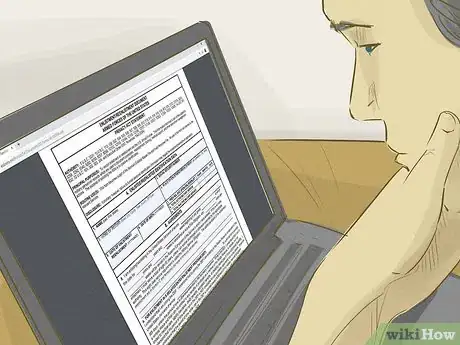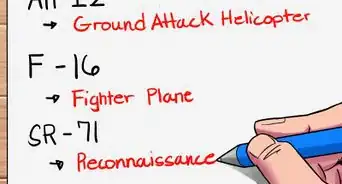This article was co-authored by wikiHow staff writer, Hunter Rising. Hunter Rising is a wikiHow Staff Writer based in Los Angeles. He has more than three years of experience writing for and working with wikiHow. Hunter holds a BFA in Entertainment Design from the University of Wisconsin - Stout and a Minor in English Writing.
There are 7 references cited in this article, which can be found at the bottom of the page.
This article has been viewed 88,280 times.
Learn more...
If you’ve reached the end of your service term in the military or you want to enlist again after being discharged, reenlisting is a similar process to when you first joined. While the rules and regulations may vary slightly between branches, each requires you to talk to a recruiter or Career Counselor to discuss your options. Once you’ve confirmed you’re eligible for reenlistment and filled out the necessary forms, all you need to do is complete a ceremony for your service!
Steps
Filing for Reenlistment
-
1Check your reenlistment code to see if you're eligible after being discharged. Reenlistment codes are printed on your DD214 forms whenever you leave service, and they give a specific reason for why you were discharged. Look for a 3- or 4-digit code starting with “RE” followed by 2 numbers or letters. Look up your branch of service and the reenlistment code online to see if you’re eligible for reenlisting in the military. If you have a code that starts RE-1, you can most likely reenlist in any branch, but codes starting with RE-4 usually cannot reenlist at all.[1]
- Discharge codes may look the same between military branches, but they each have a different meaning. For example, someone with the code RE-2 in the Army can reenlist easily, but in the Air Force, you may need to receive a review from a recruiter in order to reenlist.
- Some reenlistment codes, such as RE-3, state you cannot reenlist without a waiver from a recruiter. Reach out to a recruiter in the military branch you want to reenlist with to see what they can help you with.
- Each branch of the military has age limits for enlisting and reenlisting. The age limits are 28 for the Marines, 31 for the Coast Guard, 34 for the Army, and 39 for the Air Force and Navy.[2]
-
2Talk to a Career Counselor 90-180 days before your ETS if you’re still enlisted. If you’re still an enlisted member of the military, wait until 6 months before your Expiration of Term of Service (ETS) before talking to your Career Counselor. Let them know that you would like to reenlist and continue serving in the military. The Career Counselor will help guide you with the necessary paperwork and next steps for the reenlistment process.[3]
- You may be ineligible for reenlistment or reenlistment bonuses when you’re less than 90 days away from your ETS.
Tip: Military branches will prioritize people who are reenlisting from active duty before accepting reenlistments from those who have had prior service.
Advertisement -
3Choose if you want to keep or change your MOS. Your military occupational specialty (MOS) is the job you work during your military service. When you reenlist, you can either choose to continue the job that you’ve worked in the past or you can switch to something else. Talk with a Career Counselor or recruiter about your MOS to see if there’s an opportunity to advance your career or if help is needed in a different specialty.[4]
- If you have prior service and you’re reenlisting in the military, you may need to go through additional training, even if you choose the same MOS.
- You may not be able to reenlist with the same MOS if the job isn’t in demand.
-
4Take classification or aptitude tests if you’re changing your MOS or service branch. The Armed Forces Classification Test (AFCT) allows you to improve scores of any old tests you took when you enlisted, and it can help you qualify for reenlistment or change your MOS. If you’re planning on changing the branch of service you’re a part of, you may be asked to take the Armed Services Vocational Aptitude Battery (ASVAB) test to determine if you qualify.[5]
- If you need to take any tests, look for study guides online so you can try practice exams and learn what to expect from them.
-
5Fill out the reenlistment paperwork and give it to your Career Counselor. Ask your recruiter or Career Counselor for DD Form 4, which is the standard paperwork for enlistment and reenlistment. Fill out the portions that ask for your personal information in ink so it’s legible. Don’t write in any sections that ask for your signature or are labeled for the officer than reenlists you since you need to wait until after your ceremony. When you finish the forms, give them back to your Career Counselor or recruiter so they can submit it.[6]
- You can usually reenlist for 3-, 4-, or 6-year terms depending on your branch of service.
Completing the Reenlistment Ceremony
-
1Choose a date and place for your reenlistment ceremony. Once it’s been determined that you’re eligible for reenlistment, you can choose any day to perform the ceremony. If you’re currently enlisted, make sure the day you choose is before your ETS so you don’t have any lapse of service. Then, you can choose any location to hold your ceremony, such as a building where you’re stationed, a banquet hall, or a classroom.[7]
- Some branches have restrictions on where the ceremony can take place. For example, the Air Force requires you to reenlist at your home station unless you are deployed somewhere else.
- Other branches will let you reenlist anywhere you want as long as an officer can give the Oath of Enlistment.
- Look up where other military members have had their reenlistment ceremonies to get ideas for where to hold yours.
Tip: You can invite guests, such as other military personnel or family, to your reenlistment ceremony if you want. Be sure to choose a location that guests can easily get to if you invite them.
-
2Pick who will administer the Oath of Enlistment to you. The person who administers your reenlistment must be a commissioned officer in your military branch, but it can usually be anyone you choose. If you pick someone who isn’t stationed near you, send them an email in advance so they have time to respond and get to the location. Otherwise, you can have your commanding officer give you the Oath.[8]
- You can also choose any officers that are retired, but not if they resigned their commissions.
-
3Wear your military uniform for the ceremony. Anyone getting reenlisted in the military must wear the appropriate uniform during their ceremony to make it official. Make sure your uniform is clean and pressed for the ceremony so you look professional. Don’t leave out any pieces of your uniform or you may not be able to complete the ceremony.[9]
-
4Raise your right hand and repeat the Oath of Enlistment. The officer you chose to give you the ceremony will ask you to recite the Oath of Enlistment. Raise your right hand so your palm faces forward and repeat the Oath after the officer recites it. Be sure to speak loud and clear so you don’t accidentally mess up the Oath. When you’re finished, the officer will sign the paperwork your Career Counselor or recruiter gave you.[10]
- The Oath of Enlistment is “I, (your name), do solemnly swear (or affirm) that I will support and defend the Constitution of the United States against all enemies, foreign and domestic; that I will bear true faith and allegiance to the same; and that I will obey the orders of the President of the United States and the orders of the officers appointed over me, according to regulations and the Uniform Code of Military Justice. So help me God.”
Community Q&A
-
QuestionWhat is the best reason to reenlist?
 Community AnswerIt gives you purpose - most people don't have anything lined up outside of their career in the military, which leaves many people feeling lost when they get out and wishing that they could change their decision.
Community AnswerIt gives you purpose - most people don't have anything lined up outside of their career in the military, which leaves many people feeling lost when they get out and wishing that they could change their decision. -
QuestionCan I reenlist to go back into the military?
 Community AnswerYou may reenlist as long as you were not dishonorably discharged or have a medical condition that prevents you from joining again.
Community AnswerYou may reenlist as long as you were not dishonorably discharged or have a medical condition that prevents you from joining again. -
QuestionCan I re-enlist in the military if I am in my late 30s?
 Community AnswerThe military has raised the age cap from 29 to 38. You can be even older if your age minus your prior years of active duty is less than 40.
Community AnswerThe military has raised the age cap from 29 to 38. You can be even older if your age minus your prior years of active duty is less than 40.
References
- ↑ https://www.dd214.us/reference/Reenlistment_Codes.pdf
- ↑ https://www.usa.gov/join-military
- ↑ https://www.nationalguard.com/eligibility/prior-service
- ↑ https://www.hrc.army.mil/content/Reenlistment%20and%20Reclassification%20IN~2FOUT%20Calls%20for%20Regular%20Army%20Soldiers
- ↑ https://www.hrc.army.mil/TAGD/Army%20Personnel%20Testing
- ↑ https://www.esd.whs.mil/Portals/54/Documents/DD/forms/dd/dd0004.pdf
- ↑ https://static.e-publishing.af.mil/production/1/af_a1/publication/afi36-2606/afi36-2606.pdf
- ↑ https://static.e-publishing.af.mil/production/1/af_a1/publication/afi36-2606/afi36-2606.pdf
- ↑ https://static.e-publishing.af.mil/production/1/af_a1/publication/afi36-2606/afi36-2606.pdf



















-Step-10-Version-3.webp)















































